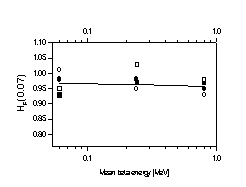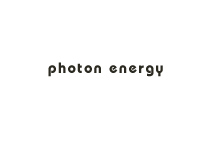 MCP-Ns - TL dosimeters
The new thin layer MCP-Ns (LiF:Mg,Cu,P) TL dosimeters designed to measure personal dose equivalent Hp(0.07) in fields of weakly penetrating radiation, have been recently developed in Kraków [1-3]. These detectors show
- flat energy response for X-rays and for beta-rays
- high sensitivity to allow reliable measurement of doses in the microgray range
- good reproducibility and mechanical stability
Physical form
Detectors have a form of circular pellets with diameter 4.5 mm. Each pellet consists of two layers: a thin radiation sensitive part bonded to a thick base made of not activated LiF to which 2% of graphite was added in order to suppress any spurious luminescence. The effective thickness of the sensitive layer is about 8.5 mg.cm-2. The overall thickness of the pellet is between 0.5 mm and 0.9 mm depending on requirements of the customer.
Oven annealing is recommended, however reader annealing is also possible. Oven annealing should be performed at 240oC for 10 min, with detectors placed on thin aluminium or stainless steel plate. After annealing period the plate should be removed from the oven and cooled down to room temperature on a thick (c.a. 1 - 4 cm) aluminium plate. To remove low temperature peaks an annealing at 100oC for ten minutes after irradiation should be applied.
This figure shows beta energy response with respect to Co-60 of MCP-Ns irradiated with Pm-147, Tl-204 and Sr-90/Ir-90 sources under 2.0 mg.cm-2 foil. Data points represent different angles of irradiation: (n) 0o, (o) 20o, (l) 40o, (ˇ) 60o. Solid line represents values averaged over four angles of incidence.
|
 |
 |
This graph presents photon energy response of MCP-Ns, normalised to Cs-137 gamma-rays. The observed decrease for 100 keV X-rays is typical for all LiF:Mg,Cu,P based detectors. The overall deviation of the response is lower than 20% down to energies below 20 keV.
|
| Effective thickness [mg.cm-2] |
8.5 |
| Relative sensitivity to TLD-100 |
1 |
| Zero dose reading [mGy] |
4 |
| Detection threshold [mGy] |
3 |
| Linearity range [Gy] |
10-5 * 10 |
| Repeatability |
< 2% |
| Thermal fading [% at room temperature] |
< 5% / yr |
| Fluorescent light effect on fading and zero reading |
negligible at laboratory light intensity |
| Reusability |
unlimited |
| Dose rate influence |
independent |
Copyright (c) 2001-2005 TLD Poland
|























